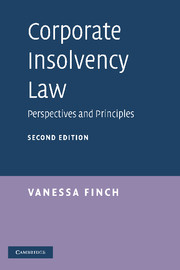Book contents
- Frontmatter
- Contents
- Acknowledgements
- Table of cases
- Table of statutes and other instruments
- List of abbreviations
- Introduction to the second edition
- PART I Agendas and objectives
- PART II The context of corporate insolvency law: financial and institutional
- PART III The quest for turnaround
- 6 Rescue
- 7 Informal rescue
- 8 Receivers and their role
- 9 Administration
- 10 Pre-packaged administrations
- 11 Company arrangements
- 12 Rethinking rescue
- PART IV Gathering and distributing the assets
- PART V The impact of corporate insolvency
- 18 Conclusion
- Bibliography
- Index
9 - Administration
Published online by Cambridge University Press: 05 June 2012
- Frontmatter
- Contents
- Acknowledgements
- Table of cases
- Table of statutes and other instruments
- List of abbreviations
- Introduction to the second edition
- PART I Agendas and objectives
- PART II The context of corporate insolvency law: financial and institutional
- PART III The quest for turnaround
- 6 Rescue
- 7 Informal rescue
- 8 Receivers and their role
- 9 Administration
- 10 Pre-packaged administrations
- 11 Company arrangements
- 12 Rethinking rescue
- PART IV Gathering and distributing the assets
- PART V The impact of corporate insolvency
- 18 Conclusion
- Bibliography
- Index
Summary
The Cork Committee, as we have seen, placed emphasis on the value of insolvency processes that provide ways of rescuing troubled companies, as well as help realise corporate assets. Its recommendations led to the procedures governing administration orders and company voluntary arrangements (CVAs) that are set out in the Insolvency Act 1986. This chapter examines the administration regime, as now revised by the Enterprise Act 2002, considers how this regime tends to satisfy the values set out in chapter 2 and reviews the philosophy underpinning modern administration.
The rise of administration
The roots of administration can be seen in the Cork Committee's belief that corporate rescue could often be furthered by allowing an independent expert to take over the management of a distressed company. Cork noted that one particular advantage flowed from the floating charge holder's power to appoint a receiver and manager over a company's undertaking: receivers were given extensive powers to manage and, in some cases, had been able to restore troubled companies to profitability and return them to their former owners. In others, the receivers had been able to dispose of all or part of the business as a going concern and, in either case, the preservation of the profitable parts of the enterprise had been ‘of advantage to the employees, the commercial community and the general public’.
- Type
- Chapter
- Information
- Corporate Insolvency LawPerspectives and Principles, pp. 363 - 452Publisher: Cambridge University PressPrint publication year: 2009

